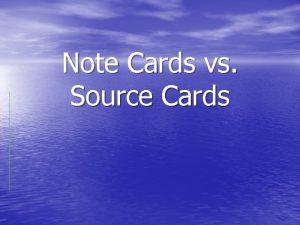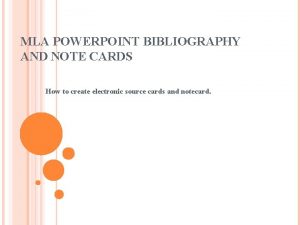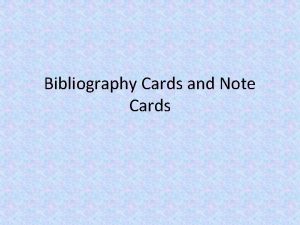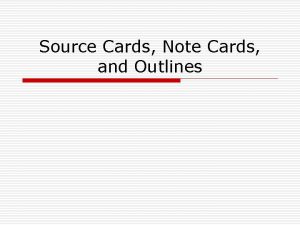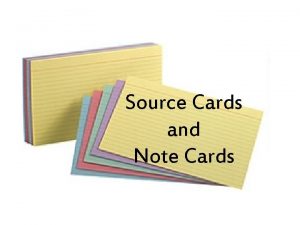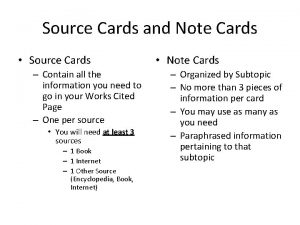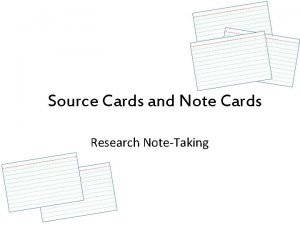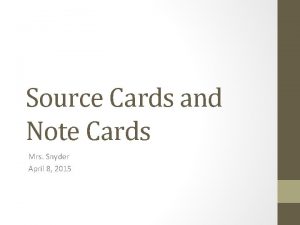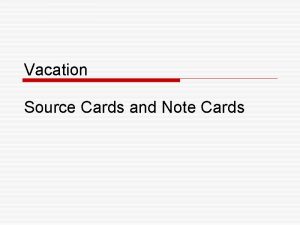How to Create Note Cards and Source Cards











- Slides: 11

How to Create Note Cards and Source Cards Mini Research Project

Source Cards Is a Source Card the same as a Note Card? No. A Source Card contains bibliographic information about your sources. A Note Card contains the direct quotation, paraphrase, or summary of one main idea from a book, article, or other document you are using for your research paper. You should always create a Source Card first, and then create your Note Cards. Sometimes teachers have students use 4”x 6” index cards for Note Cards to distinguish them from the 3” x 5” Source Cards are sometimes called Bibliography Cards or Bib Cards for short. What goes on a Source Card? • Source # • Source citation (the exact information that you would put on the Works-Cited page

What is Bibliographic Information? It is the information about the book, article, or other source written in MLA style. Generally, the author (last name, first name), the title of the work, the place the work appeared, the place the work was published, the publisher, the date. Consult the MLA handbook or Purdue OWL Website for specific formats. What is a Source Number? Information on a Source Card written in the upper right-hand corner of the card and circled. Assign a different number to each source you find. You will use this number to refer to sources on Note Cards containing material from that source. This number will not appear in your paper.

Bibliographic Information: The information about the book, article, or other source in MLA style. Generally, the author (last name, first name), the title of the work, the place the work appeared, the place the work was published, the publisher, the date. Consult the MLA handbook or Purdue OWL website for specific formats. Source Number: Information on a Source Card written in the upper right-hand corner of the card and circled. Assign a different number to each source you find. You will use this number to refer to sources on Note Cards containing material from that source. This number will not appear in your paper.

Note Cards Suggestions for Note Cards Write on only one side of each 3 x 5 or 5 x 7 card. You will need a note card for quotations, an author’s ideas, statistics, graphs and charts. Make a separate note card for each idea or quotation you might want to use in your paper. Put quotation marks around material that is copied word for word. If you find the information in 3 or more sources and put it in your own words, it is common knowledge and doesn’t require that you document the source. It will be difficult during the early stages of reading and taking notes to determine what is common knowledge, so if you write it on a note card, give the source.

Explanation of the Parts of the Note Card Label - The label is used to categorize the notes you are taking under several descriptive headings. Labels allow you to arrange your notes in some logical order according to the topics and subtopics in your preliminary outline. You will arrange your cards according to their labels before you write your page. You may not be able to label your note card as soon as you take the note. This may have to be done after you’ve had time to reflect on your reading and note taking. Page Number & Author– The exact page number where you found the citation should be noted on the card. Keep in mind that online databases and the Internet do not have page numbers. You may also opt to write down the author’s name to save you from looking at the source card when you are drafting your paper, The Source – This refers to where you found your information. It is always enclosed in parentheses. Note Card # – This number corresponds to the number you wrote on your source card. Note Card Letter- indicates multiple notecards per source The Note – This can be a summary, a paraphrase, or a quotation from a book, a magazine article, an online database, or the Internet. This is the information that you will use to write your paper; in fact, you should be able to write your paper by using your note cards and not have to refer back to the sources of information. Be sensible about note taking. You will have more cards than you need to write your paper, but do not take down every detail and do not duplicate material.

What information do you write on a notecard? Direct quote: when you take a sentence or idea WORD FOR WORD Paraphrase: you take the idea of an article that isn’t your own but put it into your own words. Summary: you create a brief description of the information as a whole

Notecard Label/Header (Topic) Notecard # and letter Type of info Source information: Direct quote, paraphrase, summary Author last name and page number

Source Card 1 Gabriel, Trip. "The New York Times Upfront | The News Magazine for High School. " The New York Times Upfront | The News Magazine for High School. N. p. , 25 Oct. 2010. Web. 11 Mar. 2013.

Note Card Topic: Statics about Plagiarizing 1 A Direct Quote “In surveys conducted by Mc. Cabe that tracked thousands of college students, 40 percent admitted to plagiarizing a few sentences in written assignments, and 61 percent admitted to cheating on assignments and exams” Gabriel 22

Notecard Practice! Topic: Dystopian “The world was bankrupted of ten million fine actions the night he passed on. ” Found on page 149 of Fahrenheit 451 by Ray Bradbury
 The source card
The source card Difference between note making and note taking
Difference between note making and note taking Note making and note taking difference
Note making and note taking difference Difference between note making and note taking
Difference between note making and note taking Draw a specimen of debit note
Draw a specimen of debit note What is debit note
What is debit note Relevance of note making
Relevance of note making Mla format note cards
Mla format note cards Research paper source cards
Research paper source cards Quotation note card
Quotation note card Bibliography card
Bibliography card How to make source cards
How to make source cards
